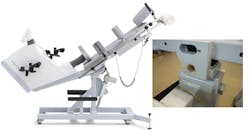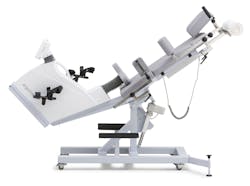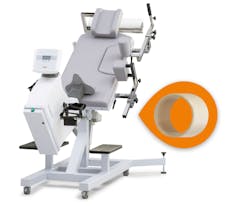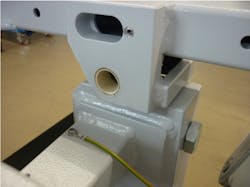Sometimes in manufacturing, the tried-and-true principles of machine design simply don’t work. Slow-moving supply chains are the antithesis of a climate that demands speed, innovation and adaptability. Time is money, and no one understands that phrase more than manufacturers who face high product demand. Quality still counts, but speed and efficiency are now tightly interwoven into the manufacturing process.
Solutions, however, are elusive. Producing quality components takes time. Workplaces are finding it hard to hire enough workers, and the supply chain seems as unreliable as the rust-covered links on the 43-year-old Schwinn stuffed in your grandfather’s garage.
A German manufacturer of recumbent ergometers faced such a challenge. The units are used in exercise and for diagnosing heart diseases. The company, ergoline Gmbh, needed wear-resistant and lubrication-free bearings in a custom dimension so that it could start production of its new series of ergometers. A swift solution was required.
READ MORE: Lubricating Plastic Gears and Bearings
Creating bearings from bar stock was too time consuming and expensive, and the company could not wait six weeks for a tool to make the bearings. igus, the German manufacturer of motion plastics, offered the customer its FastLine service, an innovative new resource which features modern computerized numerical control (CNC) technology. The time from order to delivery was four days.
The rapid turnaround is a common theme in the current worldwide manufacturing climate, where customers seek speedy answers to their design challenges. igus is a materials provider that pushes the innovation envelope, and its new service focuses on delivering parts to customers quickly.
“Delivery time has been an issue since the early days of igus,” said Tom Krause, head of 3D printing at igus. “Our founder, Günther Blasé, relied on a modular tool design in the first years. Over the years, however, the requirements became more and more time-critical and have become even clearer in the past 10 years.”
Diagnosing Heart Disease
Worldwide statistics focused on heart disease are staggering. In 2020, approximately 19.1 million deaths were attributed to cardiovascular disease, according to the American Heart Association. The agency estimates that 244.1 million people globally were living with ischemic heart disease in 2020.
Eastern Europe has one of the highest prevalence rates of IHD in the world. The U.S. ranked 142nd in the world in coronary heart disease deaths in 2020, according to the World Health Rankings, and Germany ranked 155th. In both nations, the percentage of deaths attributed to heart issues topped 20%.
Diagnosing heart diseases makes the health risk even more complicated. One important examination for diagnosing heart health concerns and therapy is a stress ECG, in which a medical ergometer is used to ensure reproducible stress on patients. Ergoline is a leading producer of the medical devices and has specialized in producing a wide variety of high-quality medical ergometer designs for more than 30 years.
More than 60,000 ergometers from ergoline have been in use worldwide. The company also manufactures equipment used for cardiac diagnostics (for performing stress ECGs in clinics and after surgeries, for example) and develops equipment and software for training and monitoring patients in cardiac rehabilitation.
“These systems are especially common in rehabilitation clinics and sports medicine centers,” says Dominik Huber, head of design at ergoline GmbH. “All components—such as plain bearings—must be durable and able to withstand a wide range of loads, such as acceleration and high weight.”
Getting Smart on the Heart
One of ergoline’s products, the ergoselect 1200 model, is a reclining ergometer developed for the purpose of dynamic stress echocardiography. In simpler terms, the procedure evaluates cardiac structure and function during physical exercise (or the pharmacologic simulation of exercise) by measuring increased heart rate, cardiac output and myocardial oxygen demand. The procedure allows for echocardiographic images to be obtained anywhere along the continuum from rest to peak physiologic stress.
The ergometer can be electrically adjusted horizontally or laterally between 0° and 45°, allowing special ultrasound heart examinations during an ergometric stress test.
Huber sought a plain bearing to support the adjustment mechanism for height and tilt. The company selected igus’ iglide P210 bearing, which works well in pivoting movements on various shaft materials.
The bearing requires no external lubrication and thus meets the stringent demands for the medical field. It is also extremely durable. While the bearing solved one problem, however, others arose.
Faster Turnaround Time
Shaft modifications in the product resulted in too much clearance from items that had been selected from the igus catalog. “Since production was about to begin, we initially decided to turn a small number of the parts from bar stock,’’ Huber said. Volume production, however, required an even faster solution.
“Six weeks for a regular tool was too slow for us and continuing to turn bearings from bar stock was too time-consuming and expensive,’’ Huber said.
READ MORE: A Gallery of Common Bearings
igus offered its FastLine service to hasten the turnaround time. “By investing in our tool shop with its own production line for round parts that features modern CNC technology, we were able to produce specially shaped plain bearings for ergoline within a very short time,” said Benjamin Haupt, technical sales consultant at igus.
In CNC, computer instructions guide mills and lathes that control the precision of the instruments. The process enables the development of parts and components that would usually be impossible to create manually. The time from order to delivery was four days, and at a price that surprised Huber. “We had expected to pay three times as much,’’ he said. “Of course, we were very pleased. It gives us the possibility to work flexibly in design.”
More Customization
More and more customers are requiring custom parts and quick service, according to Krause.
“There are different reasons,’’ he said. “A common one is that part of a machine is broken down and it needs to be replaced, so it’s imperative to get the machine running again. Other reasons are sourcing methods failed or an expectation of getting individual parts in a few days.”
igus’ focus on speedy delivery did not begin with FastLine. It previously manufactured molds from aluminum for time-critical developments and later added in print2mold (3D printing). “The advantage of FastLine is that we have a mold that is 100% suitable for series production and is not limited in the number of shots in injection molding,” Krause said.
In 2014, igus introduced its first 3D-printing filaments, which are made especially for moving applications because of the solid lubricants, Krause said. In 2016, it introduced its first SLS material, iglide i3, and started with its SLS 3D print service. “Since then, our customer interest was constantly growing, so that we now have 10 SLS machines worldwide,” he said. “We are able to produce special wear parts very quickly in Boston, Shanghai and Cologne. Last year, we made more than 200,000 special wear parts by 3D printing.”
Life in the Fast Lane
igus’ FastLine service was created to meet the needs of manufacturers with high product demand. Customized parts, such as plain bearings in unique shapes, have to be delivered without complications. Injection molding can require several weeks. With its expanded in-house toolmaking department, igus can deliver plain bearings in special dimensions in a few days and at cost-effective prices.
“By investing in our toolmaking department with its own production line for round parts with modern CNC technology, we are now able to respond even faster to our customers’ needs,” said Stefan Loockmann-Rittich, business unit manager of iglide at igus. “In addition to our large catalog range of polymer plain bearings, which are available from stock, we can produce customized parts cost-effectively in just a few days using the appropriate injection molding tool.”
Customers can determine if injection molding or another production is more cost-effective with the iglide Designer. The online tool allows the customer to enter the dimensions of the plain bearing, select the desired material and define the quantity. The program will show an overview of the manufacturing processes with the appropriate costs.
Ergometers and More
In the ergometer, specially sized plain bearings are pressed into the bearing point where they ensure reliable, safe adjustment even with dynamic forces of 1.3 tons. The bearings are ideal for ergometers in that they are lightweight, corrosion-free and resistant to dust and dirt.
The example with the ergoline is one example of the depth to which igus can use its 3D and FastLine innovations to speed up industrial processes. 3D printing has even been used in energy chain applications, for instance. In one case, mounting brackets and moving ends for the energy chains were developed in a large-scale 3D printer.
READ MORE: No Grease: Tribologically Optimized Plastic Bearing Materials
In another application, iglide i6 material was used to develop glide pad adapter clips for energy chains. The clips serve as a ramp to relieve the glide pads, extending their service life. The material improves the lifetime of bearings by six times compared to its predecessors, even for temperatures over 212°F.
“Mostly we produce parts for our customers with their own design,” Krause said. “Bearings, gears, sliders and other friction parts are the most printed parts. For energy chains, 3D printing is already used in the prototyping phase and in the start of the series. For the bigger quantities, injection molding is still more cost effective. When a special design is needed and quantities are not big enough for molding, 3D printing is used as a bridge technology to move things along faster.”
With the genie now escaped from the bottle, there is no turning back. Production cycles, Krause said, are going to continue to accelerate. “Shorter product cycles for consumer goods and more leaps in innovation in a short time are driving this accelerated schedule,” he said. “In order to be competitive on the market, our customers must be willing to adapt to meet this new demand.”
Thomas Renner writes on building, construction, engineering and other trade industry topics for publications throughout the United States.




